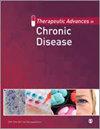塔法米地改善 A97S 转hyretin 心脏淀粉样变性的心肌纵向应变
IF 3.3
3区 医学
Q2 PHARMACOLOGY & PHARMACY
引用次数: 0
摘要
背景:转甲状腺素心肌病(ATTR-CM)是一种使人衰弱的疾病,自从出现新的治疗方法以来,这种疾病一直备受关注。转甲状腺素心肌病临床试验显示,转甲状腺素四聚体稳定剂他非米迪能有效降低患者的功能和生活质量。然而,在主要的 ATTR-CM tafamidis 试验中,Ala97Ser(A97S)遗传性 ATTR-CM 的代表性不足。研究目的我们旨在研究A97S ATTR-CM患者在接受12个月的他法米迪治疗后,全身纵向应变(GLS)的变化。方法我们回顾性分析了国立台湾大学医院接受他法米迪巨鲁明(61 毫克/天)治疗的 A97S ATTR-CM 患者的前瞻性队列。在基线和治疗后 12 个月进行了带有斑点追踪应变分析的超声心动图检查。结果共有 20 名患者被纳入队列。基线左室射血分数(LVEF)和室间隔厚度(IVS)分别为 59.20 ± 13.23% 和 15.10 ± 3.43 mm。他法米迪治疗 12 个月后,LVEF 和 IVS 分别为 61.83 ± 15.60% (p = 0.244) 和 14.59 ± 3.03 mm (p = 0.623)。GLS 从 -12.70 ± 3.31% 显著改善至 -13.72 ± 3.17% (p = 0.048),心尖段和中间段的纵向应变 (LS) 分别从 -16.05 ± 4.82% 显著改善至 -17.95 ± 3.48% (p = 0.039) 和 -11.89 ± 4.38% 显著改善至 -13.58 ± 3.12% (p = 0.039)。亚组分析显示,LVEF<50%的患者治疗反应较好,GLS也有所改善。IVS ⩾ 13 mm 患者的两腔 LS 从 -10.92 ± 4.25% 改善到 -13.15 ± 3.87% (p = 0.042),心尖左室 LS 从 -15.30 ± 5.35% 改善到 -17.82 ± 3.99% (p = 0.031)。结论他法米迪能明显改善 A97S ATTR-CM 患者的 GLS,尤其是心尖和中间 LS。本文章由计算机程序翻译,如有差异,请以英文原文为准。
Tafamidis improves myocardial longitudinal strain in A97S transthyretin cardiac amyloidosis
Background: Transthyretin cardiomyopathy (ATTR-CM) is a debilitating disease that has received much attention since the emergence of novel treatments. The Transthyretin Cardiomyopathy Clinical Trial showed that tafamidis, a transthyretin tetramer stabilizer, effectively reduced the declines in functional capacity and quality of life. However, Ala97Ser (A97S) hereditary ATTR-CM is underrepresented in major ATTR-CM tafamidis trials. Objectives: We aim to investigate the change in global longitudinal strain (GLS) of A97S ATTR-CM patients after 12 months of tafamidis treatment. Methods: We retrospectively analysed a prospective cohort of patients with A97S ATTR-CM who received tafamidis meglumine (61 mg/day) at the National Taiwan University Hospital. Echocardiography with speckle tracking strain analysis was performed at baseline and 12 months after treatment. Results: In all, 20 patients were included in the cohort. The baseline left ventricular ejection fraction (LVEF) and interventricular septum (IVS) thickness were 59.20 ± 13.23% and 15.10 ± 3.43 mm, respectively. After 12 months of tafamidis treatment, the LVEF and IVS were 61.83 ± 15.60% (p = 0.244) and 14.59 ± 3.03 mm (p = 0.623), respectively. GLS significantly improved from −12.70 ± 3.31% to −13.72 ± 3.17% (p = 0.048), and longitudinal strain (LS) in apical and middle segments significantly improved from −16.05 ± 4.82% to −17.95 ± 3.48% (p = 0.039) and −11.89 ± 4.38% to −13.58 ± 3.12% (p = 0.039), respectively. Subgroup analysis showed that patients with LVEF < 50% had a better treatment response and improvement in GLS. The patients with an IVS ⩾ 13 mm had an improvement in two-chamber LS from −10.92 ± 4.25% to −13.15 ± 3.87% (p = 0.042) and an improvement in apical left ventricular LS from −15.30 ± 5.35% to −17.82 ± 3.99% (p = 0.031). Conclusion: Tafamidis significantly improved GLS, and particularly apical and middle LS in A97S ATTR-CM patients.
求助全文
通过发布文献求助,成功后即可免费获取论文全文。
去求助
来源期刊

Therapeutic Advances in Chronic Disease
Medicine-Medicine (miscellaneous)
CiteScore
6.20
自引率
0.00%
发文量
108
审稿时长
12 weeks
期刊介绍:
Therapeutic Advances in Chronic Disease publishes the highest quality peer-reviewed research, reviews and scholarly comment in the drug treatment of all chronic diseases. The journal has a strong clinical and pharmacological focus and is aimed at clinicians and researchers involved in the medical treatment of chronic disease, providing a forum in print and online for publishing the highest quality articles in this area.
 求助内容:
求助内容: 应助结果提醒方式:
应助结果提醒方式:


